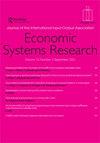西班牙的税收改革:效率水平和分配模式
IF 1.8
4区 经济学
Q2 ECONOMICS
引用次数: 0
摘要
本文以西班牙为例,对一个欧洲国家最相关的税收类别及其分配模式的效率水平进行了近似分析。这是在计算这些税收的“边际”超额负担时完成的,同时考虑到2010年以来进行的重大税收改革前后西班牙税收体系的结构。在此过程中,我们使用静态应用一般均衡模型,其特征是根据应税收入分类的异质家庭。此外,以同样的方式,本文还评估了另一种替代性税收改革:统一的增值税制度和减少雇主的社会保障缴款。我们的研究结果表明,替代税制改革将略微提高这些税收的效率程度,同时暗示对总收入的负面影响较低。在分配效应方面,我们没有发现实际税收政策和替代税收政策之间存在显著差异。本文章由计算机程序翻译,如有差异,请以英文原文为准。
Tax reforms in Spain: efficiency levels and distributional patterns
This paper approximates the efficiency levels of the most relevant tax categories and their distributional patterns for a European country considering Spain as an illustrative example. This is done computing the ‘marginal’ excess burden of these taxes, taking into account the structure of the Spanish tax system before and after the major tax reforms undertaken since 2010. In doing so we use a static applied general equilibrium model, which features heterogeneous households classified according to their taxable income. In addition, and in identical terms, another alternative tax reform is evaluated: a flat value-added tax system and a reduction in employers’ social security contributions. Our results indicate that the alternative tax reform would have slightly improved the degree of efficiency of these taxes while implying a lower negative impact on aggregate income. Regarding distributive effects, we do not find significant differences between the actual and the alternative tax policies.
求助全文
通过发布文献求助,成功后即可免费获取论文全文。
去求助
来源期刊

Economic Systems Research
ECONOMICS-
CiteScore
5.60
自引率
4.00%
发文量
17
期刊介绍:
Economic Systems Research is a double blind peer-reviewed scientific journal dedicated to the furtherance of theoretical and factual knowledge about economic systems, structures and processes, and their change through time and space, at the subnational, national and international level. The journal contains sensible, matter-of-fact tools and data for modelling, policy analysis, planning and decision making in large economic environments. It promotes understanding in economic thinking and between theoretical schools of East and West, North and South.
 求助内容:
求助内容: 应助结果提醒方式:
应助结果提醒方式:


